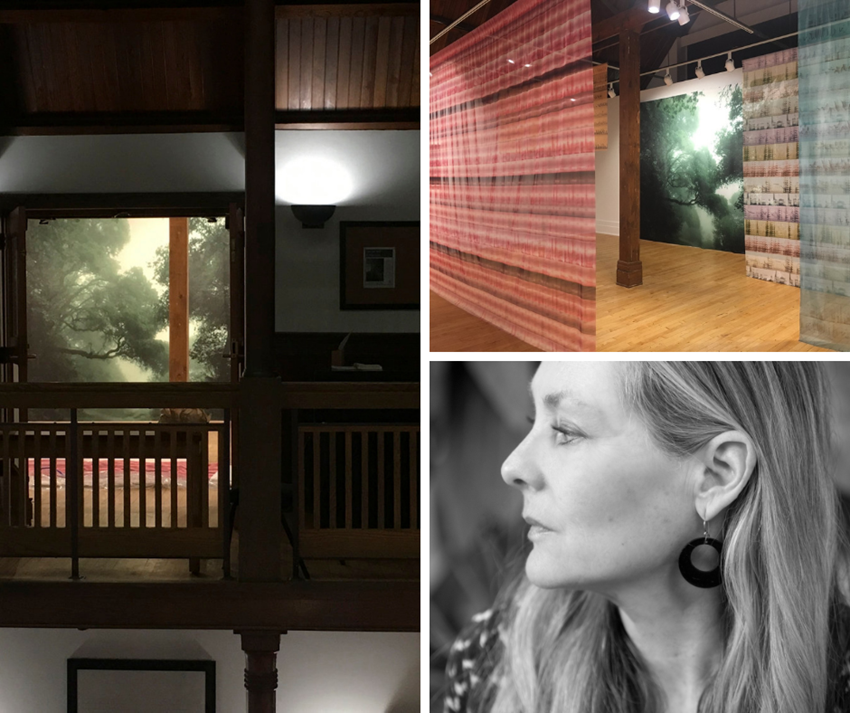A Conversation with OpenAIR MT Artist-in-Residence Alice Q. Hargrave
Recently, OpenAIR MT sat down with FLBS 2020 Fall Artist-in-Residence Alice Hargrave to discuss her work.
What drew you to the Open AIR Artist-in-Residence program?
Hargrave: Throughout my work I have always been interested in the relationships between and bridging together art and science, most recently with my current project :
Lake Stories and what the water will tell ...
How a changing climate is affecting global freshwater lakes
This project led me to Flathead Lake and to the Open AIR residency program. To be able to work on this project, at this beautiful location, on the shores of Flathead Lake is truly a dream. I love that I can hear the lake and the birds 24/7 — listening to the changing rhythms of the water and the many birds and other animals in this pristine habitat. Couple that with having access to world renowned scientists, their expertise, data, and enthusiasm, makes for an amazing artistic, research driven collaboration.
I have already received elucidating data about Flathead Lake that is incorporated into the work and I have been able to enjoy the isolation and quiet that is so essential to making, especially now in 2020 with all the worldly troubles and distractions that this year has brought on.
How would you describe your work?
Hargrave: I work with the photographic medium in a way of translation rather than capture. I am interested in visualizing the invisible - and by using abstraction as another vehicle to understand the world.
For example, In my Last Calls/Pink Noise work I create abstract patterned “portraits” of the most threatened and endangered birds of the world. They are constructed using Spectrogram recordings, sound files depicting sound wave patterns of actual bird calls. Reminiscent of hieroglyphics, I photograph these avian vocalizations, layer, and tone the sound wave patterns using the surprising colors of eyes, talons, skin, or plumage of each particular species, contradicting the ubiquitous argument “Why save that simple brown bird”?
Color becomes advocacy !
Tell us about your most recent solo exhibition?
Hargrave: I have created several different site-specific installations of the Last Calls work including photographically printed silk fabrics that are hung in layers throughout a space. Often the semi- transparent fabrics, each representing a different species, are hung in varying depths, and layered over landscapes where research has shown the birds used to thrive.
A recent one - person exhibit was titled Last Calls, On any given night ... migratory season across the Mississippi Flyway. I was thinking about the magical notion that during certain times of the year thousands of birds are traveling over our heads throughout the night. I think of the installations like figure / ground relationships — the landscape or “ground” in this case was a 16’ opaque silk forest and in front of it were hung the “figures” or calls of the birds — for example the endangered CA Condor, that one thinks of as primarily black in color, actually has hot pink and salmony pink skin - so the fabric reflected those colors.
I am very interested in archives and cannot wait to delve into the archives here at the FLBS Museum, Ecology, and Zoology buildings. My installations incorporate sound archives from The Cornell Lab of Ornithology - I love the cadence of the voices of the researchers from the 1950’s for example, which are included alongside the bird calls — describing field conditions, dates, times, and the catalog numbers of each recording. It is important for me that the audience know that we are hearing a mediated source and call attention to the practice and need for salvaging and archiving voices of distant or potentially extinct birds. I have been making sound recordings here of the lake for my “Lake Playlist” that will incorporate the sounds of several global lakes and be immersive in the space for Lake Stories.
What led you to work 2D/3D?
Hargrave: I enjoy juxtaposing traditional two dimensional photographic prints alongside three dimensional installations. I consider each image as unique, and believe in the adage — form follows function — in other words, I think each image begs it’s own scale so I treat each image independently. In exhibitions I play with varying scale and rhythm across a wall.
For the Lake Stories project I have been collecting the bathymetry of several global lakes. I make 2D images of layered photographs (sometimes archives) with the bathymetry of the lakes — they are like patterned fingerprints of each lake. No two lakes are the same in terms of shape or three dimensional form. I am in the process of making cast glass pieces of the unseen part of the lakes, turning the bathymetry data into 3D files that can then be turned into molds for the glass. FLBS is a great resource for me to help create these elaborate 3D files. Once again making the invisible visible - underlining the fact that “If you have seen one lake .... you have seen one lake” a refrain from the GLEON conference last year. (Global Lake Ecological Observatory Network)
I am very grateful to be able to make, read, live, and immerse myself into all things - lake - while here for a generous five week stay.
“A lake is a landscape's most beautiful and expressive feature.
It is Earth's eye; looking into which the beholder measures the depth of his own nature.”
Henry David Thoreau


